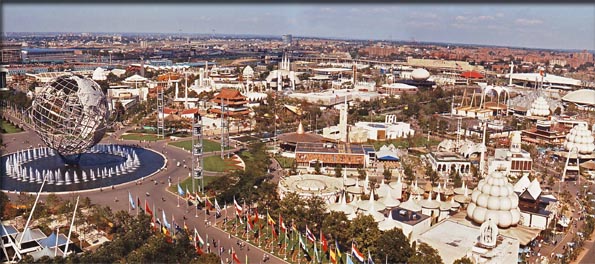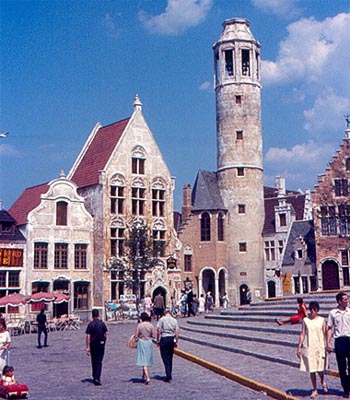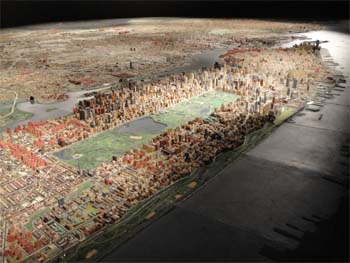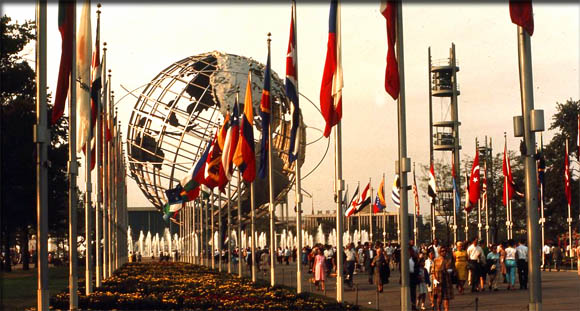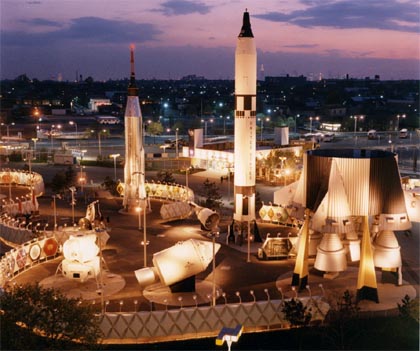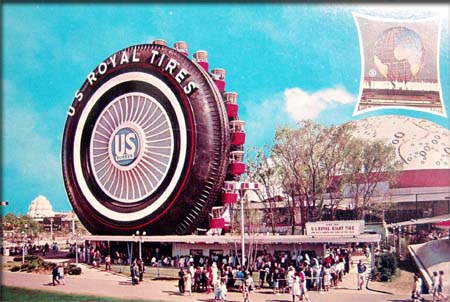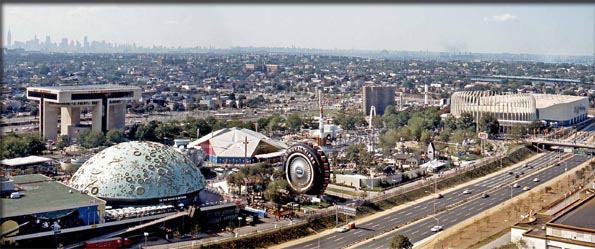pop up description layer
HOME
Cryptozoology UFO Mysteries Aviation Space & Time Dinosaurs Geology Archaeology Exploration 7 Wonders Surprising Science Troubled History Library Laboratory Attic Theater Store Index/Site Map Cyclorama
Search the Site: |
|
A Half Century Ago: The 1964/65 New York World's Fair
(5/14) Fifty years ago, on April 22, 1964, the World's Fair opened in New York City. It looked forward to a world where technology solved all of man's problems, wants and needs. Perhaps its goals were a bit optimistic, but it was fun, anyway. There's a great big beautiful tomorrow, shining at the end of every day. - There's a Great, Big Beautiful Tomorrow, - Richard M. Sherman &Robert B. Sherman I first visited the fair in 1964 as a six-year-old boy. For members of the baby-boomer generation, if you were lucky enough to be taken to this international exposition, I think it had an impact on how you viewed the world for much of your early life. For me, the song from the GE exhibit, There's a Great,Big Beautiful Tomorrow, for right or wrong, encapsulated the spirit of the entire exhibition. There's a great big, beautiful tomorrow and it's just a dream away! In this case the dream belonged to New York's "master builder," Robert Moses. Moses was involved in the 1939-1940 New York World's Fair and when he was approached by a group of businessmen about doing a sequel 25 years later, he looked at it as an opportunity to complete his vision of converting a garbage dump/tidal marsh into Flushing Meadows Park. Part of this area had been the site of the earlier fair, but financial problems had stopped Moses from completing the conversion back in '39. A new fair, located in the same place, would give him a second chance. International Disagreement The fair was controversial from the beginning. In order to break even on the cost, the organizers knew they would need around 70 million people to visit the exposition. To get this many visitors would mean that the fair would have to run for two six-month seasons instead of the usual one. The organizers also realized that they would need to charge site rental fees to the foreign exhibitors instead of giving them the space for free.
Unfortunately, these needs were in direct conflict with the Bureau of International Expositions' (BIE) rules. The BIE, headquartered in Paris, was the international organization that sanctioned world's fairs. Further complicating any approval was another rule stating that no nation could host more than one international exposition per decade and a world's fair had already been approved for Seattle in 1962. Moses traveled to Paris and tried to persuade the BIE for an exception, but didn't get it. It was quite possible to hold the fair without BIE approval (the 39/40 Fair hadn't had it), but this almost guaranteed that none of the BIE member nations would participate. However, Moses and the organizers got around this by contacting trade and tourism organizations in those countries whose governments wouldn't sponsor a pavilion. They managed to get representation of some sort from a number of countries including Spain, Indonesia, Belgium, France, Sweden, Taiwan, Jordan, Sierra Leone, Guinea, and Egypt. There were some gaping holes in international participation, however, including the nations of Great Britain, Germany (though West Berlin had a pavilion), Canada and the Soviet Union. Disney Showcase The lack of international government participation, I suspect, had the effect of increasing the impact that business and industry exhibitors had on the fair, making it more of a commercial exposition. However, I have to admit that to my six-year-old mind this was not a problem. I found that the best and glitziest exhibits at the fair seemed to be from corporations. As I mentioned before, the theme song of the General Electric exhibit pretty much represented the whole fair to me. GE's contribution was called the Carousel of Progress. It was a round building where multiple sets of seats rotated around a number of stationary stages at the structure's core. As the audience was carried from stage to stage (to the tune of the theme song), they were shown how technical progress had bettered life in American homes starting at the beginning of the 20th century and running through some post 60's future. Technical innovations such as the refrigerator and air conditionerwere highlighted.
Perhaps the most interesting technical innovation on display at the Carousel of Progress was the cast of the show: Walt Disney's Audio-Animatronics robots. This was one of the first chances for the public to see Walt's synthetic actors and it was certainly the thing that stuck in my young mind. They could do show after 15-minute-show with no lunch breaks or sick days. The Carousel of Progress was one of the exhibits that survived the end of the fair. It was moved to Disneyland and later Disney World. For this reason, probably more people remember this remnant of the fair than almost anything else (though the final segment had to be updated from time to time to avoid the future from looking like the past). From various visits to Disney parks over the years, the show is still fresh in my mind. Even today I can still sing the lyrics to the There's a Great Big Beautiful Tomorrow, without looking them up. GE wasn't the only corporation that turned to Disney for help with a pavilion. Ford's exhibit had visitors climb into a train of Ford convertibles called the Magic Skyway. (This used the same mechanics, I understand, as the "People Mover" that would be later employed in Disneyland's Tomorrowland ). Riders were taken past a moving diorama that included dinosaurs and a "City of Tomorrow" complete with bubble-domed buildings. Post fair, the dinos also went to Disneyland and could be seen from the steam railway near Main Street USA. The state of Illinois also used Audio-Animatronics in their "Great Moments With Mr. Lincoln" show. Disney built a robotic version of the 16th president that gave a ten-minute talk, cobbled together from the real President's writings and speeches.
The Lincoln robot was extremely impressive and everybody who attended the fair remembered seeing it. This is ironic as it almost didn't appear at the exposition. The figure had been built as part of a history show planned for Disneyland. When Robert Moses visited the Disney workshops prior to the fair in regards to seeing the progress on GE's show, he was also shown Mr. Lincoln. He was so amazed by it that he knew he wanted it at the fair, so he went looking for a sponsor. He tried the federal government and Pepsi with no luck. Finally, he took his idea to the state of Illinois and convinced them to do a "Land of Lincoln" exhibit. It took some steep discounts and monetary supplements from the fair to get the state to agree to this as Lincoln's rental was beyond the Illinois budget, but in the end Moses finally got the mechanical President to his exposition. After the fair was over, Lincoln finally made it to Disneyland. Later, a duplicate was created for Disney World where he still appears today with audio-animatronic figures of all the presidents. A Small, Small World Even though Pepsi didn't host Lincoln, they did get Disney to do a show for them. This was the famous, or perhaps infamous, It's a Small World. Visitors were placed in boats which floated through a 15-minute ride surrounded by child-sized robotic figures outfitted in garb from all around the world. As visitors watched, they sang the theme song while dancing their national dances. The Pepsi show was the last project Disney took on for the fair. The idea started with former company President Alfred Steele's wife, the actress Joan Crawford. She had a personal connection with Walt and asked him to take on the project. The company had only eleven months to put together the show which Pepsi envisoned as a "Salute to UNICEF and the World's Children." At first the concept was that as the boats passed through each country, its respective national anthem would be heard. Because the total area of the ride was so cramped, however, this resulted in a cacophony of noise, so Walt got the Sherman Brothers (who were also responsible for There's a Great, Big Beautiful Tomorrow) to compose a simple, upbeat, song that could be sung as a round in different languages. The song, It's a Small World, has taken a beating over the years as being extremely repetitive and overly cheery, but by some estimates is the single most-performed and translated piece of music on Earth. The exhibit, which was renamed from "Children of the World" to match the title of the song, was moved to Disneyland after the fair. Later it was duplicated for Disney World in Florida as well as the Disney Parks in Paris, Tokyo, and Hong Kong. A sixth installation is now being constructed for Disney's Resort in Shanghai.
You might think from the above list that everything cool at the fair was built by Disney. This, of course, was not the case. One of the most interesting installations that I can recall from the fair was from business giant IBM. Their theater was in the form of a huge, slightly-squashed egg suspended on pylons high in the air and covered with the IBM logo. The audience would climb into rows of sharply-sloping seats (dubbed "the people wall") then the entire wall was pushed by hydraulic rams up into the base of the egg. Inside a film entitled Think (I can't really remember what the show was about, just how it was presented) was shown on 22 screens of various sizes. In the area under the egg were various smaller displays presenting short demonstrations of computer logic or mathematics. One that sticks in my mind involved a Sherlock Holmes puppet who at the end opened his coat to reveal that he was actually a computer. Another popular exhibit was hosted by the city of New York itself. Inside this pavilion was a gigantic model allowing visitors to take an imaginary helicopter ride around the metropolis without really leaving the ground. The building, which had originally been built for the 1939 World's Fair, still survives today as the Queens Museum of Art. The giant model, the Panorama of New York, is still on display and has been updated with changes to the city since the fair. This year the museum is also exhibiting some 900 vintage fair souvenirs recently brought out of storage for the anniversary. The Hall of Science was another favorite of mine. Outside the cathedral-like building was a space park loaded with huge rockets pointing into the sky. Inside there were several exhibits, but the highlight was a presentation by Martin-Marietta where two full-sized spacecraft of the future rendezvoused over the audience's heads. The Hall of Science survived the fair and today is a hands-on science and technology center. Dinoland Perhaps one of the best exhibits in the fair didn't look forward into the future, but back into the past. At Sinclair's Dinoland you could see nine full-sized, fiberglass, moving dinosaurs in a park-like setting. The biggest was a Brontosaurus (that today might more correctly be called an Apatosaurus, but that's another story) 27 feet high and 70 feet in length. The Brontosaurus was the Sinclair company's symbol. Under his feet was a visitor center housing a 45-foot-long display showing a timeline of the earth's prehistory, complete with "erupting volcanoes, flashing lightening and bubbling streams." Perhaps the coolest thing about the Sinclair exhibit was a set of vending machines (apparently marketed under the name Mold-A-Rama) that would make you a model of one of the dinosaurs. You would drop in a couple quarters and watch two halves of a metal mold close. Then the machine would blow hot wax into the mold for a few seconds, then cool it. The mold would then open and an arm would push the figure, still warm and smelling of the wax, out through a trap door and into your hands. My brother and I procured seven of the beasts to take home with us (unfortunately my poor T-Rex took a beating when my second grade teacher left it on the radiator overnight after a show and tell). The dinosaurs toured the country after the fair. Eventually they were split up and went to different museums across the United States where some of them still are still located today. Landmarks Though there isn't room for me to reminisce about every exhibit at the fair, I should mention a few of the landmarks that really stick in people's minds. The only thing my wife can remember of the fair (she was 4 or 5 when she attended) was the U.S. Royal Tire exhibit: an 80-foot-high giant tire. The tire also served as the Fair's ferris wheel and could carry 96 people around its edge in giant buckets. After the fair, the tire was shipped to company headquarters near Detroit, and with the ride mechanism removed, still overlooks Interstate 94 near the airport. One of the more striking buildings was the Tower of Light, a pavilion put together by a group of public electric utilities. Its exterior walls consisted of 600 aluminum prisms. At night its walls were illuminated in different colors. There was also a 12 billion-candlepower searchlight which pointed straight up. Inside visitors rode a turntable through several theaters (sort of like the GE exhibit, except that you had to stand) where the wonders of electricity were presented. It would be hard to talk about landmarks at the fair without mentioning its center piece: the Unisphere. The Unisphere was a 140 foot-high, stainless steel globe of the world that sat at the center of the exhibition and was dedicated to the fair's theme of "Peace through Understanding." It still stands in the middle of Flushing Meadows Park and occasionally, I understand, they switch on the fountains that surround it. Even if you've never been to New York, its image is probaby familiar to you from the 1997 film Men in Black where in the final sequence a crashing flying saucer knocks the globe down. Legacy Financially the fair was considered a failure. Attracting 51 million visitors instead of the needed 70 million, it barely was able to keep its gates open until its scheduled October 17, 1965, closing date. Perhaps, though, it's a little unfair to view the fair as a success only if it made money. My gut feeling was that it brought a sense of wonder to thousands, if not millions, of kids and I'm not sure you can put a price on that.
Did those predictions that science would solve all our problems come true? Well, not exactly. The videophone was demonstrated at the fair, but that never made it into production. The fair had a monorail as its transportation system of the future, but few of those are around in 2014. In the intervening years we've learned that technology isn't a panacea, but a two-edged sword that must be wielded carefully. For every wonder, like the internet, you can get a mess like the Fukushima nuclear meltdown if you aren't prudent. The twenty-fifth and now fiftieth anniversarys' of the fair have passed with no mention of the possibility of another World's Fair in New York. In fact, there has not been a World Exposition hosted in the United States since 1984 when the Louisiana World Exposition turned out to be a dismal failure. Even the 1982 fair ("Knoxville International Energy Exposition") which did turn a small profit was a disappointment to many. I attended with friends and it was only a poor shadow of what had been done in New York. One place you can go to today to get a feeling of what that NYC's grand exposition was like is in Orlando, Florida. When Walt Disney first conceived of his Experimental Prototype Community of Tomorrow (EPCOT), he actually wanted to build a utopian city. After his death, however, the company decided that without his guidance such a grandiose undertaking was ill-advised. Instead, the company took the lessons it had learned from the fair in New York and applied them in making EPCOT and created a very successful, permanent, world's fair. Perhaps these temporary expositions are simply not practical in our modern world. The BIE rule requiring the fair not run for more than six months seems to limit such exhibits to being either small or financially unsustainable. Other more specialized conventions and trade shows, like CES and even Comic-com, maybe stealing some of their thunder. Perhaps world's fairs, which were often supposed to be a vision of the future, are now a thing of the past.
For more information on the exhibits and history of the NYC World's Fair visit: http://nywf64.com/ Copyright Lee Krystek 2014. All Rights Reserved. |
|
Related Links |
|
}
|



